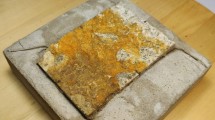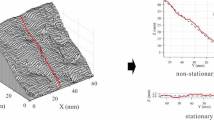Abstract
By using close range photogrammetry, this article investigates the accuracy of the photogrammetric estimation of rock joint roughness coefficients (JRC), a measure of the degree of roughness of rock joint surfaces. This methodology has proven to be convenient both in laboratory and in site conditions. However, the accuracy and precision of roughness profiles obtained from photogrammetric 3D images have not been properly established due to the variances caused by factors such as measurement errors and systematic errors in photogrammetry. In this study, the influences of camera-to-object distance, focal length and profile orientation on the accuracy of JRC values are investigated using several photogrammetry field surveys. Directional photogrammetric JRC data are compared with data derived from the measured profiles, so as to determine their accuracy. The extent of the accuracy of JRC values was examined based on the error models which were previously developed from laboratory tests and revised for better estimation in this study. The results show that high-resolution 3D images (point interval ≤1 mm) can reduce the JRC errors obtained from field photogrammetric surveys. Using the high-resolution images, the photogrammetric JRC values in the range of high oblique camera angles are highly consistent with the revised error models. Therefore, the analysis indicates that the revised error models facilitate the verification of the accuracy of photogrammetric JRC values.











Similar content being viewed by others
Abbreviations
- α :
-
Pitch of a line on a plane measured from the strike of the plane
- θ 1 :
-
Angle between the line on a plane and the line of sight
- θ 2 :
-
Angle between the normal vector of a plane and the line of sight
- h m :
-
Maximum asperity height measured by profile gauge
- h p :
-
Maximum asperity height obtained from photogrammetric profiles
- JRCo :
-
JRC values estimated based on manually measured profiles
- JRCp :
-
JRC values estimated based on photogrammetric profiles
- MAEJRC :
-
Average of the absolute error for JRC values
$${\text{MAE}}_{\text{JRC}} = \frac{{\mathop \sum \nolimits_{i = 1}^{n} \left| {{\text{JRC}}_{{{\text{o}},i}} - {\text{JRC}}_{{{\text{p}},i}} } \right|}}{N}$$ - N JRC :
-
Normalized JRC values comparing between photogrammetric profiles and manually measured data
$${\text{N}}_{\text{JRC}} = \frac{{{\text{JRC}} _{{ 3 {\text{D images}}}} }}{{{\text{JRC}}_{{ {\text{measured}}}} }}$$ - RMSEJRC :
-
Square root of the average of the squared discrepancies for JRC values
$${\text{RMSE}}_{\text{JRC}} = \sqrt {\frac{{\mathop \sum \nolimits_{i = 1}^{n} \left( {{\text{JRC}}_{{{\text{o}},i}} - {\text{JRC}}_{{{\text{p}},i}} } \right)^{2} }}{N}}$$
References
American Society for Photogrammetry & Remote Sensing (2014) ASPRS positional accuracy standards for digital geospatial data. PE & RS 81(3):A1–A26
Autodesk (2011) AutoCAD Civil3D 2011 user’s guide. Autodesk, Inc., San Rafael
Baker BR, Gessner K, Holden EJ, Squelch A (2008) Automatic detection of anisotropic features on rock surfaces. Geosphere 4(2):418–428
Barton N, Choubey V (1977) The shear strength of rock joints in theory and practice. Rock Mech 10:1–54
Bemis SP, Micklethwaite S, Turner D, James MR, Akciz S, Thiele ST, Bangash HA (2014) Ground-based and UAV-based photogrammetry: a multi-scale, high-resolution mapping tool for structural geology and paleoseismology. J Struct Geol 69:163–178
Birch JS (2009) Using 3DM analyst mine mapping suite for slope stability-case studies. In: Proceedings of ACG geotechnical engineering for open pit mines, section 17, pp 1–15
Bistacchi A, Griffith WA, Smith SAF, Di Toro G, Jones R, Nielsen S (2011) Fault roughness at seismogenic depths from LIDAR and photogrammetric analysis. Pure Appl Geophys 168:2345–2363
Chai T, Draxler RR (2014) Root mean square error (RMSE) or mean absolute error (MAE)?-Arguments against avoiding RMSE in the literature. Geosci Model Dev 7:1247–1250
Cravero M, Iabichino G, Ferrero AM (2001) Evaluation of joint roughness and dilatancy of schistosity joints. In: Proceedings of Eurock 2001, Espoo, pp 217–222
CSIRO (2012) Siro3D–3D imaging system manual, Version 5.0, ©CSIRO Exploration & Mining. www.sirovision.com
Dai F, Lu M (2010) Assessing the accuracy of applying photogrammetry to take geometric measurements on building products. J Constr Eng Manag 136:225–242
Dai F, Feng Y, Hough R (2014) Photogrammetric error sources and impacts on modelling and surveying in construction engineering applications. Vis Eng 2:1–14
Fonstad MA, Dietrich JT, Courville BC, Jensen JL, Carbonneau PE (2013) Topographic structure from motion: a new development in photogrammetric measurement. Earth Surf Process Landf 38:421–430
Fooladgar F, Samavi S, Soroushmehr SMR, Shirani S (2013) Geometrical analysis of localization error in stereo vision systems. IEEE Sens J 13(11):4236–4246
Franklin JA, Maerz NH, Bennett CP (1988) Rock mass characterization using photoanalysis. Int J Min Geol Eng 6:97–112
Fraser CS (1984) Network design considerations for non-topographic photogrammetry. Photogramm Eng Remote Sens 50(8):1115–1126
Goodman RE (1989) Introduction to rock mechanics. Wiley, New York
Grasselli G, Wirth J, Egger P (2002) Quantitative three-dimensional description of a rough surface and parameter evolution with shearing. Int J Rock Mech Min Sci 39:789–800
Haneberg WC (2007) Directional roughness profiles from three-dimensional photogrammetric or laser scanner point clouds. In: Proceedings of the 1st Canada-US rock mechanics symposium, Vancouver, pp 101–106
Haneberg WC (2008) Using close range terrestrial digital photogrammetry for 3-D rock slope modeling and discontinuity mapping in the United States. Bull Eng Geol Environ 67:457–469
Hong ES, Lee JS, Lee IM (2008) Underestimation of roughness in rough rock joints. Int J Numer Anal Met 32:1385–1403
Hsiung SM, Ghosh A, Ahola MP, Chowdhury AH (1993) Assessment of conventional methodologies for joint roughness coefficient determination. Int J Rock Mech Min Sci Geomech Abstr 30(7):329–343
ISRM (1978) Suggested methods for the quantitative description of discontinuities in rock masses. Int J Rock Mech Min Sci Geomech Abstr 15:319–368
James MR, Robson S (2012) Straightforward reconstruction of 3D surface and topography with a camera: accuracy and geoscience application. J Geophys Res 117:F03017
James MR, Robson S (2014) Mitigating systematic error in topographic models derived from UAV and ground-based image networks. Earth Surf Process Landforms 39:1413–1420
Jessell MW, Cox SJD, Schwarze P, Power W (1995) The anisotropy of surface roughness measured using a digital photogrammetric technique. Fractography: fracture topography as a tool in fracture mechanics and stress analysis. Geol Soc Spec Pub 92:27–37
Kim DH, Gratchev I, Balasubramaniam AS (2013) Determination of joint roughness coefficient (JRC) for slope stability analysis: a case study from the Gold Coast area. Landslides 10:657–664
Kim DH, Poropat GV, Gratchev I, Balasubramaniam AS (2015a) Improvement of photogrammetric JRC data distributions based on parabolic error models. Int J Rock Mech Min Sci 80:19–30
Kim DH, Gratchev I, Berends J, Balasubramaniam AS (2015b) Calibration of restitution coefficients using rockfall simulations based on 3D photogrammetry model: a case study. Nat Hazards 78:1931–1946
Lato M, Gauthier D, Quinn P, Hutchinson DJ, Kromer RA, Edwards T, Riopel J (2015) 3D data collection for rapid rock fall response situations. In: Proceedings of GEOQuébec 2015, Canada, p 513
Lee HS, Ahn KW (2004) A prototype of digital photogrammetric algorithm for estimating roughness of rock surface. Geosci J 8(3):333–341
Maerz NH, Franklin JA, Bennett CP (1990) Joint roughness measurement using shadow profilometry. Int J Rock Mech Min Sci Geomech Abstr 27:329–343
Micheletti N, Chandler JH, Lane SN (2015) Structure from Motion (SfM) photogrammetry. Geomorphological Techniques, Chap. 2, Sec. 2.2, ISSN 2047-0371
Milne D, Germain P, Potvin Y (1992) Measurement of rock mass properties for mine design. Proceedings of the ISRM-Eurock symposium on rock characterization. A.A. Balkema, Chester, pp 245–250
Niethammer U, James MR, Rothmund S, Travelletti J, Joswig M (2012) UAV-based remote sensing of the Super-Sauze landslide: evaluation and results. Eng Geol 128:2–11
Palmström A (2001) In-situ characterization of rocks. Tokyo: A.A. Balkema Publishers, Lise, Abingdon, p 2001
Piteau DR (1970) Geological factors significant to the stability of slopes cut in rock. In: Proceedings of the on planning open pit mines, Johannesburg, South Africa, pp 33–53
Poropat GV (2008) Remote characterization of surface roughness of rock discontinuities. In: Proceedings of the 1st Southern hemisphere international rock mechanics symposium, Perth, Australia, Potvin Yves, CSIRO, Curtin University of Technology, University of Western Australia et al, pp 447–458
Poropat GV (2009) Measurement of surface roughness of rock discontinuities. In: Proceedings of the 3rd CANUS rock mechanics symposium, Toronto, May 2009, Paper 3976
Priest SD (1985) Hemispherical projection methods in rock mechanics. George Allen & Unwin, London
Reeves MJ (1985) Rock surface roughness and friction strength. Int J Rock Mech Min Sci Geomech Abstr 22(6):429–442
Ryan JC, Hubbard AL, Box JE, Todd J, Christoffersen P, Carr JR, Holt TO, Snooke N (2015) UAV photogrammetry and structure from motion to assess calving dynamics at Store Glacier, a large outlet draining the Greenland ice sheet. Cryosphere 9:1–11
Sturzenegger M, Stead D (2009) Close-range terrestrial digital photogrammetry and terrestrial laser scanning for discontinuity characterization on rock cuts. Eng Geol 106:163–182
Tatone BSA, Grasselli G (2010) A new 2D discontinuity roughness parameter and its correlation with JRC. Int J Rock Mech Min Sci 47:1391–1400
Tse R, Cruden DM (1979) Estimating joint roughness coefficients. Int J Rock Mech Min Sci Geomech Abstr 16:303–307
Unal M, Yakar M, Yildiz F (2004) Discontinuity surface roughness measurement techniques and the evaluation of digital photogrammetric method. In: Proceedings of the 20th international congress for photogrammetry and remote sensing, ISPRS, pp 1103–1108
Vasuki Y, Holden EJ, Kovesi P, Micklethwaite S (2014) Semi-automatic mapping of geological structures using UAV-based photogrammetric data: an image analysis approach. Comput Geosci 69:22–32
Weisstein EW (2002) Point-line distance–3-dimensional. MathWorld, A Wolfram Web Resource. http://mathworld.wolfram.com/Point-LineDistance3-Dimensional.html
Westoby MJ, Brasington J, Glasser NF, Hambrey MJ, Reynolds JM (2012) ‘Structure-from-Motion’ photogrammetry: a low-coast, effective tool for geoscience applications. Geomorphology 179:300–314
Willmott WF (2010) Rocks and landscape of the Gold Coast Hinterland. Society of Australia, Queensland
Willmott CJ, Matsuura K (2005) Advantages of the mean absolute error (MAE) over the root mean square error (RMSE) in assessing average model performance. Clim Res 30:79–82
Yu X, Vayssade B (1991) Joint profiles and their roughness parameters. Int J Rock Mech Min Sci Geomech Abst 28(4):333–336
Acknowledgments
This research was performed with the financial support of the Griffith University Postgraduate Research Scholarship (GUPRS). The authors would like to express their appreciation to CSIRO for providing the programme Sirovision for this study.
Author information
Authors and Affiliations
Corresponding author
Rights and permissions
About this article
Cite this article
Kim, D.H., Poropat, G., Gratchev, I. et al. Assessment of the Accuracy of Close Distance Photogrammetric JRC Data. Rock Mech Rock Eng 49, 4285–4301 (2016). https://doi.org/10.1007/s00603-016-1042-9
Received:
Accepted:
Published:
Issue Date:
DOI: https://doi.org/10.1007/s00603-016-1042-9




